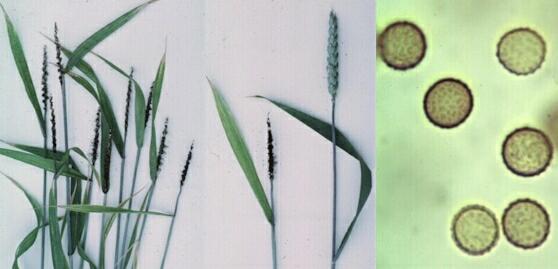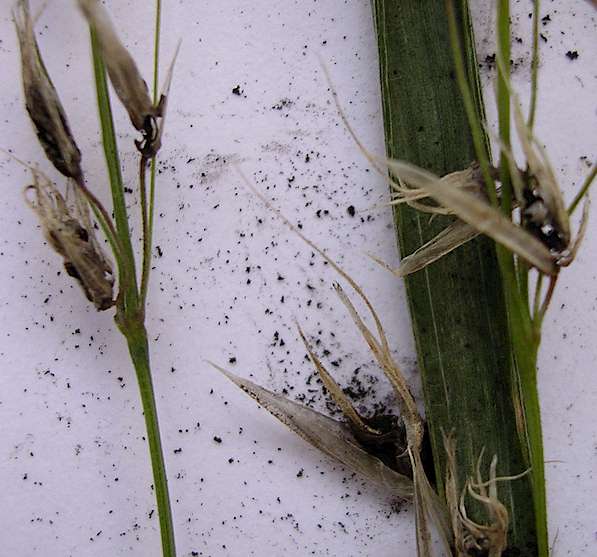..
SMUT FUNGI (BASIDIOMYCOTA) The smut fungi (Basidiomycota - Order Ustilaginales) are a group of about 1,000 species of pathogens that parasitise flowering plants - most commonly the grass family (Gramineae) and the sedge family (Cyperaceae). They are termed smut fungi because they produce a mass of black, powdery spores (teliospores) that often develop in place of the grain in cereal crops or in place of other organs such as the anthers of some flowering plants (e.g. the wild plant Silene alba). Fig. 1 (below) illustrates this in the case of Ustilago nuda (loose smut of wheat and barley). The left-side panel shows several smutted heads of wheat, where the flower spike emerged as the plants approached maturity but the fungus then produced masses of teliospores in place of the grain. The centre panel shows a comparison between a smutted head and a normal flowering head which would eventually produce wheat grains. The right-side panel shows a close-up of the teliospores (about 7-8 micrometres diameter) with characteristic wart-like projections on the spore coats. These teliospores are released before the normal grains would mature, and they can be carried by wind and germinate on a suitable host.
Fig 1. Loose smut of cereals caused by Ustilago nuda. [© Jim Deacon] A similar smut fungus, Ustilago avenae, causes loose smut of oats and of the related wild grass, Arrhenatherum elatius (false oat grass). Figs 2 and 3 illustrate this in more detail. All the flowers where the seeds would have developed on these naturally infected grass spikes have been replaced completely by smut spores.
Fig 2. Smutted seed heads of false oat grass infected by Ustilago avenae. [© Jim Deacon]
Fig 3. Smutted seed heads of false oat grass at high magnification. Note the mass of black spores that developed in place of all the grains on these plants [© Jim Deacon] The teliospores of smut fungi are dikaryotic (each hyphal compartment contains 2 nuclei - one of each mating compatibility group). These spores arise from dikaryotic hyphae that grow systemically within the plant host without causing any sign of disease. But as the plant starts to mature the dikaryotic hyphae proliferate, then the 2 nuclei of each compartment fuse to form diploid cells, and the walls thicken to produce the mature spores, which are dispersed by wind. The smut spores germinate in various ways, but in U. avenae they produce a germ tube. The diploid nucleus enters the germ tube and undergoes meiosis, producing 4 compartments each with a single haploid nucleus. The four compartments then produce buds (sporidia) which can give rise to further budding cells while the fungus grows in a yeast-like growth form. However, the haploid yeast-like form cannot give rise to infective hyphae until the sporidia of compatible mating types fuse to establish a dikaryon. In loose smut of cereals (Ustilago nuda) the smutted heads arise on plants that are already systemically colonised by the fungus. The embryos of the seeds are infected, so that the infection is repeated in the following season. Infection by Ustilago avenae is somewhat different, because smut spores can land on the flowering heads and initiate infection of the seed as it germinates. There are several other variations in the development of different smut fungi, but the most notable general point is that all the smut fungi live in intimate balance with their host plants. They grow slowly and progressively as the plant develops, without unduly impeding the plant's development, and in natural conditions (unlike agricultural conditions of monoculture) the degree of infection is likely to be self-regulating. |


